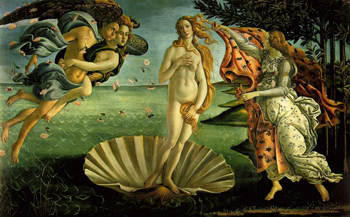
The Birth of Venus

|
The Birth of Venus was painted by Botticelli at the height of his creative powers. In it, the Greek goddess of love is shown riding on a shell, surrounded by the winds. Greek and Roman mythology clash here, as Venus is the Roman name for the Greek god Aphrodite. The ancient myth of her birth as told by Hesiod runs as follows:
Gaia (Earth) castrated her son and husband Uranus (Sky) for his wickedness, and tossed his genitals into the ocean. From them was created great foam, and within that foam grew the beautiful goddess called Aphrodite (Venus).
In Botticelli’s version, she is carried to the shore on a great scallop shell, blown by the wind (with puffy cheeks) who carries a personified breeze (the female). Waiting on shore for Venus is another female preparing to clothe the goddess in a pink robe. She wears rings of myrtle (the tree of Venus) around her neck. The draperies and Venus’ blond hair are blown by the wind and echo the translucent whitecaps of the sea.
Venus dominates the painting and is the focus of all eyes, both of the observer and of the painted figures, while her own gaze is fixed on another plane. She is framed by the surrounding figures, yet she remains isolated from them and from the viewer. A sense of sweet melancholy runs throughout the painting; a state of mind that preceded Botticelli’s spiritual crisis.
The classical poets were made popular by the artists and thinkers of the Renaissance, as the Italians tried to recapture the glory of ancient Rome. To them, the Greeks and Romans had an ancient wisdom, and their legends must contain some profound truth.
Many texts attempt to explain Venus in a Catholic setting, pegging her as the Virgin Mary blown by lustful zephyrs (the wind gods), and standing on the shell as the heavens rejoice.
The painting was commissioned by a member of Florence’s Medici family, probably by Lorenzo di Pierfrancesco de’ Medici.












